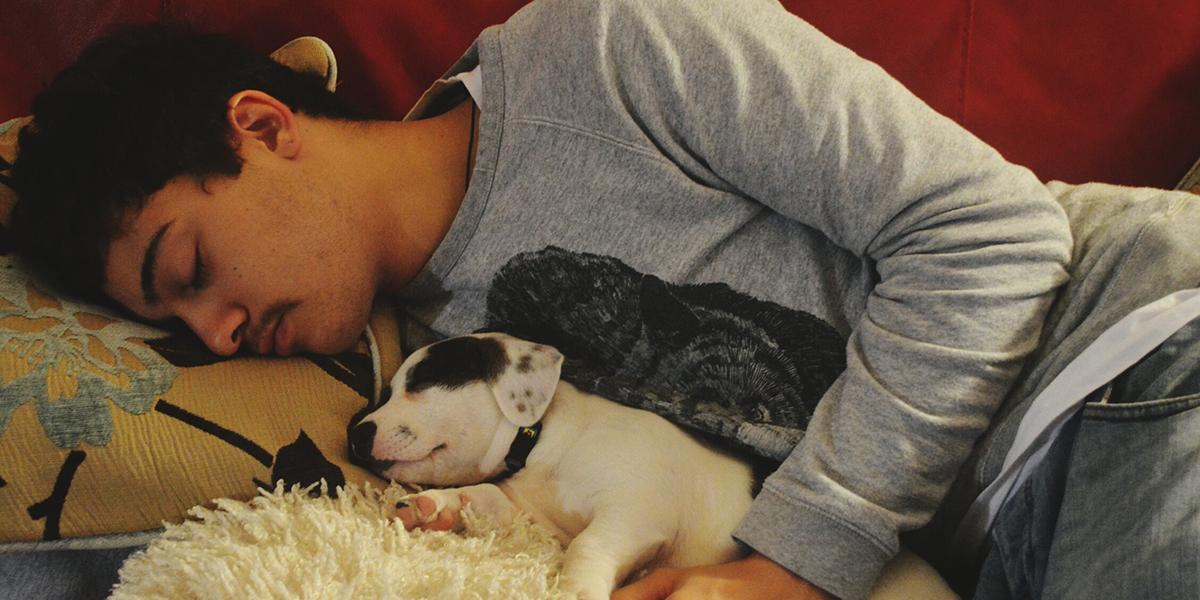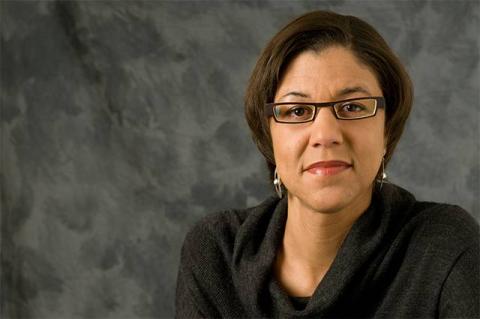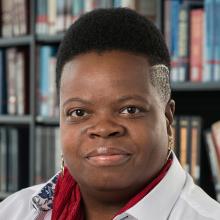Uncovering the Story of Youth Homelessness
In new study Voices of Youth Count, Gina Samuels challenges stereotypes and points to new intervention opportunities by asking homeless youths to tell their stories.
By Mark Sheehy
VOLUME 25 | ISSUE 1 | SPRING 2018

ABSTRACT
Across the country, thousands of young people are without permanent homes. Service providers and policy makers have not known how many of these young people exist or how to meet their needs. That picture is changing due to the work of a study called Voices for Youth Count that is sponsored by Chapin Hall at the University of Chicago and led in part by SSA Associate Professor Gina M. Samuels. Samuels and SSA Assistant Professor Shanta R. Robinson worked on the study, which included interviews with 215 homeless youth. These interviews showed that the youth saw their experiences with homelessness starting long before they entered a shelter or were on the street. They talked about a childhood of instability and loss, poverty, and foster care. Despite those set backs, many of the youth expressed optimism and hope for their future.
____________________________________________________________________________________________________________________
Privileged white kids running away from home. Some combination of substance abuse and a misplaced sense of adventure encouraging teenagers to play at dumpster diving. These are common stereotypes of youth homelessness, and, for a long time, there was little research to challenge these views. But a new study called Voices of Youth Count, led in part by SSA associate professor Gina Samuels, is upending the stereotypes and producing the rigorous data policymakers and service providers need to effectively address the issue.
"Our country lacks a reliable national estimate of how many homeless youth there are or a clear understanding of the processes by which they become or stay homeless," says Samuels. "So the primary motivation behind the study was to close the gaps in knowledge that have been hindering our ability to inform sound policy and practice decisions.”
Voices of Youth Count is a multi-component initiative sponsored by Chapin Hall at the University of Chicago. Samuels led the qualitative component, which also included the participation of then post-doctoral fellow Shantá Robinson, (now an SSA Assistant Professor) and SSA/Chapin Hall Harold Richman Post-doctoral Fellow Susanna Curry.
Voices of Youth Count employed several research innovations, including a multi-method, multicomponent approach. The first two of these components included a count of homeless and unstably housed young people aged 13 to 25 in 22 counties across the United States and a qualitative data collection comprising tablet-based survey and in-depth interviews with 215 homeless young people in five of the 22 target counties. The qualitative surveys and interviews explored the subjects’ experiences with housing instability over time, as well as specific questions about their education; employment; formal service involvement; identities tied to race, sexuality, and gender; parenting; and involvement with the child welfare and justice systems.
Other components in Voices of Youth Count include a provider survey to illuminate what services are available to runaways, unaccompanied homeless, and unstably housed youth; a national survey, conducted in partnership with Gallup, that asked 26,161 adults about young people in their households who have run away, couchsurfed, or experienced homelessness during the past year; a systematic evidence review of promising youth homelessness interventions; a review of existing data, including data from the U.S. Department of Housing and Urban Development and Department of Education (HUD), (DOE) to get a better understanding about the scale of youth homelessness; and a policy and fiscal review to understand how different programs and funding structures shape the services that homeless young people get.

“In addition to being the first study of its kind to attempt a comprehensive national assessment of the scope of youth homelessness and the factors that contribute to it, there were several aspects of the study’s design and methodology that made the data especially rich and actionable,” says Samuels. One was that a constellation of policymakers, providers, and politicians interested in youth homelessness policy were involved in the project from its inception, ensuring that the research questions the study asked provided the data these stakeholders needed to develop, fund, and assess new programs and interventions. “Having all of these partners at the table from the beginning holds the potential for the research to be translated into the policy world in a much more direct and immediate way,” says Samuels. “We were forging stakeholder relationships while we were designing and conducting the research, and ideally those relationships will continue as our findings evolve into policy and program proposals.”
According to Chapin Hall Executive Director Bryan Samuels, “We were also very intentional about making sure that the design of the study was organized around the existing federal policy framework so we could understand the extent to which existing federal framework was influencing outcomes. Replication was important, too. We wanted to use research methods that could be adopted by the public sector in an ongoing way to inform whether they were making progress. So, for instance, we could have taken a more sophisticated approach to the household survey, which might have been interesting from a purely academic perspective, but the public sector wouldn’t have been able to replicate it.”

The most common stereotype I encounter is that homeless youth are rebellious, obstinate, middle or upper class white kids. There’s definitely a racialization and a classing of homeless youth. --Gina M. Samuels, Associate Professor
Colette L. Auerswald, Associate Professor and Community Health Sciences Director at the UC Berkeley-UCSF Joint Medical Program notes that although HUD has conducted point-in-time counts of the homeless population of minors on a single night in January since 2005 and a separate count of 18-24-year-olds, (added in 2013), the process has been less than optimal. “Although counting transitional aged youth as part of the point-in-time counts has been an important advancement, the findings have been plagued with challenges, yielding numbers that are widely recognized as vast undercounts. Being able to count and characterize the population nationally and longitudinally may continue to be elusive. However, in a world of imperfect counts, the University of Chicago work is a welcome addition.”
Another important aspect of the project was the direct involvement of homeless or formerly homeless youth themselves. They helped researchers shape the survey and interview questions in a way that would be most meaningful and understandable to other homeless youth. They also contributed to the count itself, using their own understanding of “hot spots” where youth are most likely to be found so that the count would be more thorough and accurate.
Perhaps the most novel part of Voices of Youth Count, though, was its integration of in-person interviews into the multipart methodology. Under Samuel’s supervision, researchers interviewed 215 young people across the country, which is an unusually large sample size for a qualitative study. “The interviews were also the only component in the study that spoke to all of the research questions of the initiative, with the exception of how many homeless youth there are,” says Samuels. “Combined with the data and insights we got from the surveys, the interviews really gave us a much deeper and more nuanced picture of who these young people were and how they became homeless.”
“One of the reasons I think the interviews were so successful and the data they revealed were so rich was that we encouraged the young people we interviewed think of their experience of homelessness as a story. We began each interview by asking them, ‘If you were to think of your experience with housing instability as a story, where did your story begin?’ That’s a very different question than asking them, ‘when did you first become homeless?’ The answers we often got were ‘My homelessness story begins at birth’ or ‘When I entered foster care.’ So young people see their vulnerability to homelessness starting way before they ever wound up on the street or in a shelter, which has huge implications for when we offer services and how we design interventions. I don’t know if we would have gotten that insight just from a survey, or if we as researchers used our own assumptions about literal homelessness as the starting point.”
Samuels was also surprised by how revealing the youth were during their interviews. “We often found young people to be much more comfortable and forthcoming in face-to-face interviews than they were checking boxes on the tablet survey. Some of that was likely because we were asking more probing questions, but it surprised us because it ran counter to the assumption a lot of researchers have that, because of concerns about privacy or stigmatization, people are going to be more comfortable sharing personal details in the anonymity of a survey. In our interviews, we found the opposite to be true.”
One of the many benefits of allowing the youth to tell their stories in their own way was that it revealed the complexity of how homelessness happens for young people. “Very few young people ran away from home and just stayed on the streets full time,” says Samuels. “In fact, none of the 215 young people we talked to experienced just one kind of homelessness. Most of them couch surfed. Many of them did spend time on the street. Some of them at least occasionally made use of cars or abandoned buildings or some other informal shelter. Very few of them stayed within their own town throughout the entire time they were homeless.”
The in-depth interviews also provided significant insights into how homeless and unstably housed youth make decisions for themselves. “One of the things we discovered,” says Samuels, “is that many of these young people had resources—a shelter they knew about or a relative who lived nearby who was willing to take them in, but they sometimes chose not to use those resources. The interviews let us uncover what we call their ‘logics of engagement’ by asking them why they chose not to use these resources and under what circumstances, if any, they would choose to use a given resource. What drove these logics was managing risks. Once homeless youth know about a particular resource, their next step was a calculation about whether using that resource introduced risks for added harm that might outweigh the help it would provide. For example, if a young person was gay, or lesbian, or trans and thought a particular resource—whether it was a relative or a service provider—might stigmatize them or otherwise put their identity at risk, doing without that resource might seem like a better, safer option.”
“Youth also talked about ‘passing’ at school as not homeless so that teachers and school counselors and social workers would not call child protective services. So even though homeless young people knew there were services available to them at school, they were worried—rightfully so—that, as mandated by law, school personal might engage other resources that would bring more harm than help, at least in the youth’s opinion.”

There was very little hopelessness. [The young people in our study] had wonderful, lofty aspirations for themselves. --Shantá Robinson, Assistant Professor
But perhaps the most revelatory outcome of the interviews was the extent to which they upended stereotypes of youth homelessness and revealed the complexity of factors that contribute to young people’s housing instability. “There are several stereotypes of homeless youth,” says Samuels. “The most common one I encounter is that homeless youth are rebellious, obstinate, middle or upper class white kids. So I think there’s definitely a racialization and a classing of homeless youth. There’s also often an assumption that homeless youth are on drugs, or that there is something wrong with them. The reality is that the majority of these kids come from severe economic disadvantage—23.7% of them experienced family homelessness in our study. Their parents sometimes struggle with mental illness, addiction, or other health issues. So young people find themselves homeless because they are kicked out or rejected or are fleeing deeply dangerous or highly stressed family conditions. There was not a single story in our in-depth interviews of kids coming from stable families where everything was fine with the larger family system and it was just the kid who was struggling in some way.”
Traditional stereotypes of youth homelessness also fail to account for another particularly tragic contributor to housing instability for young people—the death of a parent or caregiver. “Roughly 35 percent of the kids in our study and 40 percent of those in Cook County had lost a parent,” says Samuels, “and many of them were living in single-parent households to begin with. The tragedy of losing one’s only parent can have devastating ripple effects beyond the obvious emotional loss. In fact, recent research published in the Proceedings of the National Academy of Sciences identified the death of a parent as an overlooked source of racial disadvantage in the United States. That one-third of homeless kids have had this experience is just staggering, and it has huge implications for community- and school-based mental health needs. Service providers really need to be attuned to what happens in families when a child’s primary caregiver or parent dies, particularly in the context of poverty.”
Another frequent driver of youth homelessness was emerging adulthood. Turning 18 in a home where there is serious poverty and economic strain often comes with expectations that a young person contribute economically. When young people can’t meet those expectations, this study found they were often forced out or left on their own to avoid feeling like a burden. And emerging adulthood overlaps with emerging sexuality, so the expectations to contribute to the household are often paired with a parent learning that their young adult was pregnant or gay or lesbian or trans, creating more pressure to leave home.
The Voices of Youth Count study also dispelled the stereotype that homelessness is an urban issue. As interviews in Walla Walla County in Washington state revealed, homelessness is not only present in rural communities, it’s often more pernicious. “The kids in Walla Walla had some of the most trauma-riddled stories in our sample,” says Samuels. “Methamphetamine use was devastatingly high among both parents and the young people themselves. And that site really does represent much of what we’re hearing in the media and elsewhere about rural America—small factories and other industries die, leaving towns economically devastated. Then drugs set in and completely highjack the family and larger community. And because of the assumption that homelessness doesn’t happen in rural locations, and because the social safety net in rural communities tends to be thinner, there are few resources for youth in general, and homeless youth in particular. So youth in Walla Walla who need foster care are often sent to another county or even to another state, which takes them away from their friends and schools. There may not be a shelter in your entire town, which makes it more likely that you’re on the street. Also, Walla Walla had some of the most strict truancy laws of any of the counties in our study, which led to kids having a much higher interaction with the juvenile justice system.”

But for all the trauma homeless young people experience, many participants in the Voices of Youth Count study were remarkably resilient. “These young people were surprisingly eloquent in describing their backgrounds,” said SSA assistant professor Shantá Robinson, who was the site lead for Cook County. “They were also quite pointed about what needed to happen for them to get out of their situation. The perception is that young people don’t know what they want and we should just tell them. But they were very clear-eyed about what they needed—both what they needed to do themselves and the help they needed from outside. And there was very little hopelessness. They had wonderful, lofty aspirations for themselves. A lot of them wanted to go to college. Whether they wanted to go into business or computer science or cosmetology, they all wanted to go back to school in some way. And so among the things they’re trying to figure out is, ‘How do I apply for school when I don’t have an address?’ ‘Where do I study when the library is closed and the only quiet(ish) place is a shelter?’ These were daunting challenges, but these kids have spent their whole lives overcoming daunting challenges. The hope they had for themselves was profoundly encouraging.”